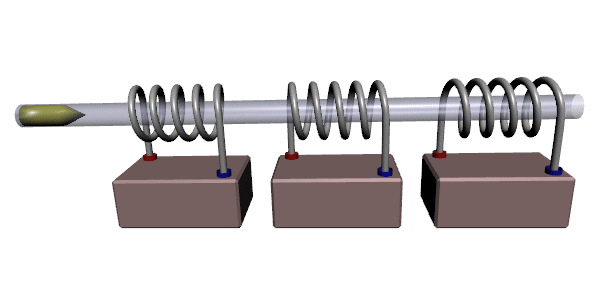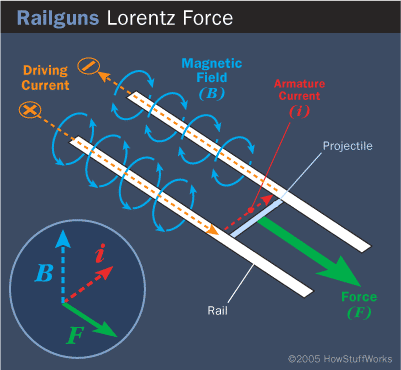So, the US Navy is about to deploy a railgun on a test bed ship, the Joint High Speed Vessel. The JHSV isn’t intended as a combat ship. It’s a testing ship. What’s moderately interesting is that I previously heard that the railgun would be installed aboard another vessel. But those things change in the military.
What I really wanted to talk about was the railgun itself. Here’s a neat video of what I’m talking about.
There are several purposes to using a railgun or other electromagnetic weapon. The one specifically mentioned by the navy is that it reduces the amount of high explosives on the ships. This means that they are safer when damaged. Many of the destroyed ships in WWII (and I presume other naval-centric wars) weren’t sunk by enemy gunfire, but when said enemy gunfire hit the ships own magazines (for example, HMS Hood). Since electromagnetic guns use magnets to accelerate the projectile and pure kinetic energy instead of an explosive payload, no chance of magazine explosions on ships.
BTW: The explosions you see in the video… that’s the air catching fire from the friction of the projectile.
Two other benefits are range and projectile flight time. The projectile travels at such a huge speed (estimated at 2.4 kilometers per second which is about Mach 7) that the projectile just doesn’t have much time to be deflected by gravity or wind. A projectile fired with that kind of velocity can also travel much, much farther.
Finally, the kinetic energy of the bullet will provide all the destructive potential that is needed on the target.
OK, but what is a railgun? How does it work? And, if you’ve read any science fiction or played any science-fiction games, you might be asking what’s the difference between a railgun, a coil gun, a magnetic linear accelerator (MLA), mass-driver, and a Gauss gun.
Last question first. The coilgun, MLA, mass-driver and Gauss gun are all the same thing. Although, for purity’s sake, I tend to only use MLA or mass-driver for non-weaponized projects. For example, using a very long system for launching spacecraft into orbit.
The coilgun is basically a series of very powerful electromagnets that turn on and off sequentially to provide a motive force to a small steel object (or object contained in a steel sheath or bucket). I think (hope) that everyone has built a small electromagnetic by wrapping wire around a steel rod and then running current through the wire with a battery. You can pick up paperclips or something small. The more times you wrap the wire, the more paperclips you can pick up. The more powerful the battery, the more paperclips you can pick up.
Now imagine a series of those small electromagnets. The first one turns one and a paperclip (or ball bearing) accelerates toward it. But, just before the paperclip gets to the electromagnet, it turns off. Another electromagnet, just a little bit farther away turns on. The paper clip continues to accelerate, pulled by that electromagnet. Again, just before it gets there, the magnet turns off and another one turns on. The paperclip continues to accelerate until you run out of electromagnets.
This is basic principle of a coilgun. Imagine a tube that the ball bearing rests in and there are very powerful electromagnets all along the tube. With some very good controls, the ball bearing can come out of the tube very, very quickly. That’s the coilgun or Gauss gun.
Now, scale that up… a lot. Instead of a small tube with a ball bearing imagine a giant tube and a spacecraft. Slow down the acceleration, but make it very, very long and it’s possible to get small spacecraft to orbit… maybe.
But the navy isn’t doing it this way. Coilguns are complicated. They need many electromagnets, that are relatively delicate. They also need very sophisticated controls, which are susceptible to damage as well.
Instead, the navy is developing a railgun, which is simple in design, but more complicated in physics.
A railgun has two long, conductive… well… rails. One is connected to the positive side of a power source, the other to the negative side of a power source. When a conductive object is lain across the rails, the circuit is completed and electrons flow through the rails. As we all know from physical science, when electrons move through something, a magnetic field is created.
The magnetic field around each rail rotates. Since the fields always follow the right hand rule[1], the combined force (along with the magnetic field in the object across the rails) produces a force that pushes the object forward. The diagram below shows this.
Now, it takes a lot of current to produce any meaningful movement in the projectile. We’re talking about a million amps or so.
The down side is (I think) that railguns require more power than coilguns. The acceleration is probably pretty difficult to control. So this wouldn’t be as effective in a non-weapon capacity, like an orbital launch system.
On last note. I think that weapons are cool. I have always felt that the military gets all the cool toys. Very few people ever build models of 747s, but lots have built models of B-52s, P-38s, and F-15s. They just look better. The tools are also very interesting from a science perspective.
The majority of weapons are little more than systems for applying a large force to a tiny area in the shortest amount of time possible. This is why you swing an axes instead of trying to push it through a tree. Armor is little more than a system for distributing large forces over as much space and time as possible. Instead of a bullet applying all of it’s force a 9mm diameter section of your skin in just a few milliseconds, body armor spreads that force out to your entire torso and “squishes” absorbing that force and spreading it out over time, further reducing the effect of the impact.
The US Navy has succeeded in developing a system that can put a very large amount of force in a very tiny area in a very short period of time. That’s the key to an effective weapon (mostly).
___________________
[1] The right hand rule. The force on the object is perpendicular to the rotation of the magnetic field. It’s called the right hand rule because if you curl the fingers of your right hand in the same direction as the fields are rotating, then your thumb points in the direction of the force. Because the flow of electrons is in opposite directions on each rail, the force (called the Lorentz Force) ends up moving in the same direction, pushing the object.


